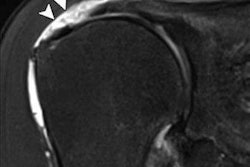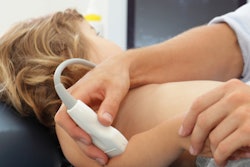
ORLANDO, FL - MRI exams performed after an initial musculoskeletal (MSK) ultrasound study are nearly always concordant with ultrasound results and rarely change clinical management, according to a Tuesday presentation at the American Institute of Ultrasound in Medicine (AIUM) conference.
Researchers from the Cleveland Clinic retrospectively reviewed all cases over a nearly four-year period in which an MRI scan was performed within 90 days after an initial MSK ultrasound. They found a very high concordance rate for reports and images from both modalities. Only one abnormality -- a deep plantar foreign body -- was found on MRI and not detected on ultrasound despite a proper clinical indication and interpretation.
"An appropriately ordered MSK ultrasound can be a definitive advanced imaging modality without the need for additional diagnostic imaging in most cases," said presenter Dr. Lulu He, a musculoskeletal radiology fellow at the Cleveland Clinic.
An alternative to MRI
MSK ultrasound is often used to evaluate patients with musculoskeletal complaints, and the modality can be a complementary, equivalent, or even preferred alternative to MRI, according to He. Launched in 2009, the Cleveland Clinic's MSK ultrasound practice currently performs more than 4,500 exams per year. The researchers had observed that MRI was occasionally ordered after ultrasound even though it hadn't been recommended by radiologists, she said.
As a result, they set out to perform a longitudinal quality improvement study to evaluate the utilization of MRI following MSK ultrasound. They wanted to identify instances where it may be possible to reduce redundant imaging exams and identify where MSK ultrasound may reduce the need for follow-up imaging, He said.
"Our hypothesis was that diagnostic MSK ultrasound is a reliable advanced imaging modality that does not require additional diagnostic [imaging] exams in most cases," she said.
After identifying all MSK ultrasound scans that had subsequent MRI exams performed within 90 days over a 47-month period, the researchers performed a retrospective chart review and recorded the ultrasound and MRI indication and reports, along with demographics, ordering, and clinical information.
Next, two musculoskeletal radiologists independently compared the ultrasound and MRI reports for each patient. The reports were categorized in one of two ways: as concordant, meaning no change or clinically insignificant, or discordant, meaning indeterminate for clinical significance.
A total of 129 cases had MRI performed after an initial ultrasound study; the average time between the ultrasound and MRI exams was 18 days. Among the specialties, orthopedics ordered the most MRI studies after an initial ultrasound exam:
- Orthopedics: 76 cases
- Primary care: 14 cases
- Podiatry: 13 cases
- Other (emergency department, pediatrics, plastic surgery, etc.): 10 cases
- Sports medicine: 9 cases
- Spine: 5 cases
- Rheumatology: 2 cases
The ankle/foot was the most common body part for which an MRI scan was ordered after an ultrasound:
- Ankle/foot: 33 cases
- Shoulder: 26 cases
- Hip/thigh: 23 cases
- Knee: 14 cases
- Wrist/hand: 12 cases
- Elbow: 9 cases
- Other upper extremity: 6 cases
- Other lower extremity: 5 cases
The researchers noted that the radiologist recommended MRI to clarify ambiguous imaging findings in 19 (15%) of the 129 cases.
Highly concordant results
Of the 129 cases, 113 (88%) had concordant ultrasound and MRI reports, while 16 (12%) were deemed to be discordant. Further review of the imaging studies in these 16 cases revealed that 11 actually had concordant ultrasound and MR images; seven of these had discordant reports due to wording variations in the reports, while one of the MRI studies was misinterpreted and three of the ultrasound exams were misinterpreted, He said.
The remaining five cases with discordant ultrasound and MRI reports also had discordant images. These included three masses that were deemed on ultrasound to be indeterminate because they were greater than 5 cm in size and deep; one case of a foreign body that was too deep to be seen on ultrasound but could be seen on MRI; and one case involving the triangular fibrocartilage complex (TFCC), an application for which ultrasound is not indicated, she said.
"Four out of the five cases with report and image discordance between MRI and ultrasound were due to inappropriate ultrasound indication or ultrasound image misinterpretation," He said. "There was only one instance when MRI caught an abnormality that MSK ultrasound did not detect despite proper indication and interpretation."
The researchers plan to perform a prospective study to determine clinicians' reasoning for ordering an MRI after ultrasound.
"Hopefully that will further reduce redundant imaging," she said. "We will continue to educate our referring clinicians in the appropriate use of MSK ultrasound to further decrease unnecessary imaging."




.fFmgij6Hin.png?auto=compress%2Cformat&fit=crop&h=100&q=70&w=100)




.fFmgij6Hin.png?auto=compress%2Cformat&fit=crop&h=167&q=70&w=250)











